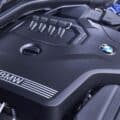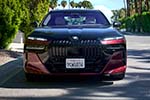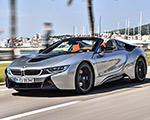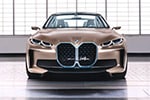Day 2 of BMW Responsibility Days 2025 shifted from strategic presentations to the operational reality behind the company’s next phase of electrification. The tour took us from Munich to Straßkirchen and Irlbach—two small communities in Lower Bavaria where BMW is building one of its most important facilities—before continuing to Landshut to talk about supplier readiness, AI integration, and more.
A High-Voltage Battery Plant in Rural Bavaria
The new Irlbach–Straßkirchen plant is situated in the middle of flat Gäuboden farmland, directly adjacent to a village of only a few thousand residents. Despite the rural setting, the scale is unmistakably industrial: a 500-meter-long, 300-meter-wide assembly hall, an energy center, logistics corridors, and a newly built fire station already equipped with six vehicles. Altogether, the site spans 105 hectares, with dedicated inbound and outbound logistics zones, new road connections, and a large-scale parking and loading infrastructure sized for over 1,000 employees and intensive daily truck movements.
By late 2026, the site is expected to produce 1,000 sixth-generation high-voltage battery packs per day, supplying BMW’s Munich, Dingolfing, and Regensburg plants as Neue Klasse production ramps up. At full workforce levels by 2028, the plant will employ around 1,600 people, supported by 540 truck movements per weekday, a 23,000 m² inbound storage facility, and a 32,500 m² supply center.
The production process follows BMW’s six-step Gen6 battery assembly logic—cell inspection, clustering, welding, foaming and sealing, energy master assembly, and end-of-line testing—supported by digital twins of all major machinery and real-time quality control.
Construction progress reflects an unusually compressed timeline for Germany. After a public permitting process that generated more than 6,000 pages of documentation, BMW received approval in April 2024. Just 19 months later, the core structures are standing, machinery is being installed, and more than 1,000 workers enter the site daily.
While BMW executives have referred to this rapid pace as “Bavarian speed,” the comparison often made internally is China—where such industrial projects can move even faster. For Bavaria, this is as close as it gets. The company now openly refers to Straßkirchen as a flagship for its iFACTORY principles: lean, green, digital, and people-focused.
Local Politics and a Difficult Referendum
As expected with large-scale industrial projects in Germany, this plant was not pushed through quietly. A citizen group mobilized significant local resistance. Concerns centered on land consumption, traffic, noise, and the fear that a village known for agriculture would be transformed into an industrial corridor.
Their efforts triggered a referendum in 2023. Turnout reached 75 percent, and two-thirds of voters ultimately approved the BMW project. The campaign left social marks that are still visible: some banners remain, and some residents continue to oppose the development. But the economic impact is undeniable.
Straßkirchen’s municipal budget has tripled. Long-requested infrastructure investments—including a bypass road—are now moving forward. Childcare funding, sewage upgrades, and several local businesses have benefited directly from the plant. The mayor openly admits the project has “changed the trajectory of the municipality.”
Several board members acknowledged that BMW had to conduct an unusually intense charm offensive: information pavilions, public Q&A sessions, and direct conversations in local restaurants like “Jedermann,” where executives answered questions late into the evening. The company made concessions on traffic routing, water management, and environmental compensation zones, including 500 newly planted trees and more than 3,000 bushes.
In short: the factory has created winners and dissenters, but it has also brought a scale of economic activity the region has not seen before.
Technical Foundations: BMW’s Sixth-Generation Battery Architecture
Inside the main hall, BMW is installing production equipment for its sixth-generation battery packs. These will use 46 mm cylindrical cells supplied by CATL and EVE from Hungary, reflecting a mixed sourcing strategy influenced by both cost and geopolitical considerations.
The shift from prismatic to cylindrical cells is central to BMW’s next EV architecture. The new batteries promise:
- 30% more range,
- 30% faster charging, and
- up to 50% lower production costs compared with current packs.
At cell level, energy density improves by around 20%, while pack-level costs fall thanks to a move toward cell-to-pack construction, eliminating modules entirely. The Gen6 pack also supports BMW’s upcoming pack-to-open-body integration, where the vehicle structure becomes an active element of the battery housing.
Higher nickel content, reduced cobalt use, and silicon-enriched anodes drive these gains. Half of the raw material input will come from recycling streams, and the remainder will be sourced through suppliers’ global networks. Battery cell production at partner sites in Hungary operates on 100% renewable energy.
Notably, the plant consumes almost no process water. Rainwater is collected, and non-production needs—canteens, sanitation—are handled via a separate water system. A 62,000 m² photovoltaic installation on the roof will help offset energy demand beginning in 2026.
A Roundtable on Supply Chain Resilience
Later in the day, BMW hosted a roundtable focused on supply chain stability and the industry’s transition toward electrification. BMW Board Member for Purchasing and Supplier Network, Nicolai Martin, emphasized a clear point: long-term supplier health is tied directly to competitiveness.
“We do not leave suppliers behind,” he said, “but every company must ensure its competitiveness. Innovation, efficiency, and data readiness are decisive factors.”
Martin underscored BMW’s operational scale: the company processes more than 36 million parts per day, backed by an annual purchasing volume of €90 billion. Electrification magnifies the complexity—battery cells are now the single largest source of upstream CO₂ in BMW’s value chain, making supply chain decarbonization a core strategic lever.
Transformation speed varies greatly by region, and BMW continues to rely on suppliers that successfully navigate the transition—from combustion-era components to EV-ready manufacturing. BMW uses digital tools such as Catena-X digital twins to increase transparency from raw materials to assembly, a capability Martin described as essential for both sustainability reporting and long-term resilience.
Localization remains a priority, but complete regional self-sufficiency is not always feasible. Martin reiterated BMW’s preference for open markets and lower trade barriers, though current policy trends point in the opposite direction.
Landshut: Supplier Development and AI Deployment
The second half of the day moved to Landshut, where BMW’s Zero Defect Campus serves as a structured training and transformation environment for suppliers. Roughly 70–80 suppliers per year participate in the two-day workshops, which combine operational theory with on-site shop floor work.
Suppliers review BMW’s production routines, KPIs, transparency tools, and communication systems—then identify five to seven elements they can implement themselves. BMW later follows up directly at supplier sites to assess progress.
Landshut itself is one of BMW’s most advanced component plants, employing 3,800 people and producing more than five million components annually. These span light metal casting, plastics, cockpit modules, cardan shafts, energy-master components for EVs, and more. The light metal foundry uses two-thirds secondary aluminum, and BMW aims to achieve 50% recycled sand usage in casting by 2026.
Quality control is increasingly automated. Every e-motor housing undergoes a CT scan capturing 2,400 images in 42 seconds, enabling structural analysis that would be impossible with manual methods. End-of-line testing is fully digitalized and integrated with plant-wide data systems.
Next door, the AI Lab highlights BMW’s digitalization push. The company has developed an internal multi-agent generative AI interface that connects LLM capabilities with real-time operational tools such as training platforms, quality databases, and production monitoring systems.
One example is AIQX, BMW’s in-house computer vision system used for optical inspections. Traditional rule-based image processing could not handle reflective surfaces or inconsistent lighting. AIQX trains custom models for each use case, improving detection rates and reducing the need for manual rework. More than 1,000 AIQX use cases are already deployed across BMW plants. Through an initiative called AI Lab on Tour, BMW is now training suppliers to adopt similar systems.
These tools are not experimental—they are being integrated into production environments and used by line workers, planners, and quality engineers.
What became clear on Day 2 is that BMW sees electrification not only as a technological shift but as an operational restructuring—one requiring new plants, new workflows, new supplier skill sets, and new digital tools.
[Photos: Rainer Haeckl © BMW AG]



















































































